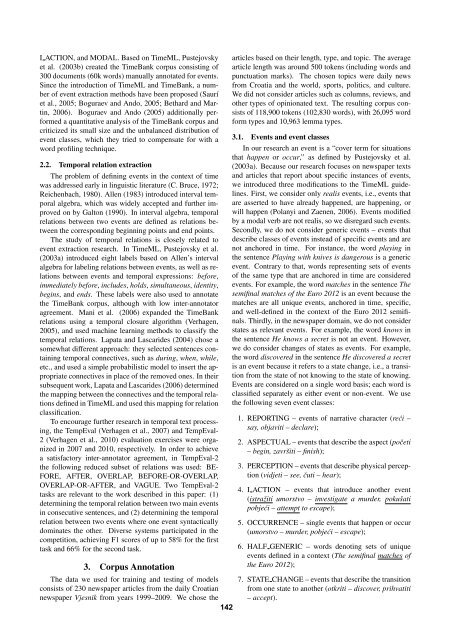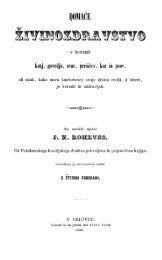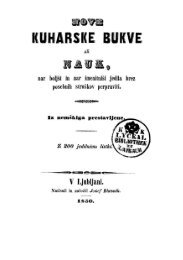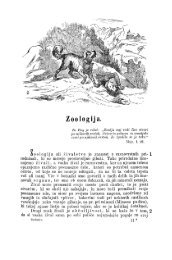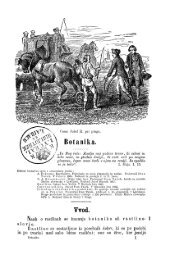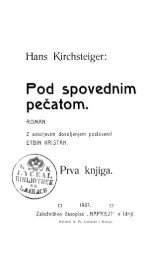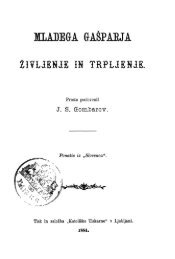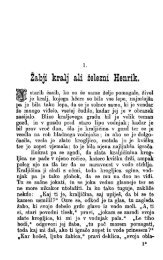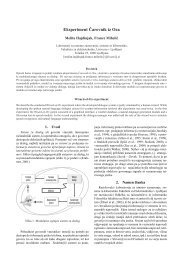Proceedings - Natural Language Server - IJS
Proceedings - Natural Language Server - IJS
Proceedings - Natural Language Server - IJS
Create successful ePaper yourself
Turn your PDF publications into a flip-book with our unique Google optimized e-Paper software.
I ACTION, and MODAL. Based on TimeML, Pustejovsky<br />
et al. (2003b) created the TimeBank corpus consisting of<br />
300 documents (60k words) manually annotated for events.<br />
Since the introduction of TimeML and TimeBank, a number<br />
of event extraction methods have been proposed (Saurí<br />
et al., 2005; Boguraev and Ando, 2005; Bethard and Martin,<br />
2006). Boguraev and Ando (2005) additionally performed<br />
a quantitative analysis of the TimeBank corpus and<br />
criticized its small size and the unbalanced distribution of<br />
event classes, which they tried to compensate for with a<br />
word profiling technique.<br />
2.2. Temporal relation extraction<br />
The problem of defining events in the context of time<br />
was addressed early in linguistic literature (C. Bruce, 1972;<br />
Reichenbach, 1980). Allen (1983) introduced interval temporal<br />
algebra, which was widely accepted and further improved<br />
on by Galton (1990). In interval algebra, temporal<br />
relations between two events are defined as relations between<br />
the corresponding beginning points and end points.<br />
The study of temporal relations is closely related to<br />
event extraction research. In TimeML, Pustejovsky et al.<br />
(2003a) introduced eight labels based on Allen’s interval<br />
algebra for labeling relations between events, as well as relations<br />
between events and temporal expressions: before,<br />
immediately before, includes, holds, simultaneous, identity,<br />
begins, and ends. These labels were also used to annotate<br />
the TimeBank corpus, although with low inter-annotator<br />
agreement. Mani et al. (2006) expanded the TimeBank<br />
relations using a temporal closure algorithm (Verhagen,<br />
2005), and used machine learning methods to classify the<br />
temporal relations. Lapata and Lascarides (2004) chose a<br />
somewhat different approach: they selected sentences containing<br />
temporal connectives, such as during, when, while,<br />
etc., and used a simple probabilistic model to insert the appropriate<br />
connectives in place of the removed ones. In their<br />
subsequent work, Lapata and Lascarides (2006) determined<br />
the mapping between the connectives and the temporal relations<br />
defined in TimeML and used this mapping for relation<br />
classification.<br />
To encourage further research in temporal text processing,<br />
the TempEval (Verhagen et al., 2007) and TempEval-<br />
2 (Verhagen et al., 2010) evaluation exercises were organized<br />
in 2007 and 2010, respectively. In order to achieve<br />
a satisfactory inter-annotator agreement, in TempEval-2<br />
the following reduced subset of relations was used: BE-<br />
FORE, AFTER, OVERLAP, BEFORE-OR-OVERLAP,<br />
OVERLAP-OR-AFTER, and VAGUE. Two TempEval-2<br />
tasks are relevant to the work described in this paper: (1)<br />
determining the temporal relation between two main events<br />
in consecutive sentences, and (2) determining the temporal<br />
relation between two events where one event syntactically<br />
dominates the other. Diverse systems participated in the<br />
competition, achieving F1 scores of up to 58% for the first<br />
task and 66% for the second task.<br />
3. Corpus Annotation<br />
The data we used for training and testing of models<br />
consists of 230 newspaper articles from the daily Croatian<br />
newspaper Vjesnik from years 1999–2009. We chose the<br />
142<br />
articles based on their length, type, and topic. The average<br />
article length was around 500 tokens (including words and<br />
punctuation marks). The chosen topics were daily news<br />
from Croatia and the world, sports, politics, and culture.<br />
We did not consider articles such as columns, reviews, and<br />
other types of opinionated text. The resulting corpus consists<br />
of 118,900 tokens (102,830 words), with 26,095 word<br />
form types and 10,963 lemma types.<br />
3.1. Events and event classes<br />
In our research an event is a “cover term for situations<br />
that happen or occur,” as defined by Pustejovsky et al.<br />
(2003a). Because our research focuses on newspaper texts<br />
and articles that report about specific instances of events,<br />
we introduced three modifications to the TimeML guidelines.<br />
First, we consider only realis events, i.e., events that<br />
are asserted to have already happened, are happening, or<br />
will happen (Polanyi and Zaenen, 2006). Events modified<br />
by a modal verb are not realis, so we disregard such events.<br />
Secondly, we do not consider generic events – events that<br />
describe classes of events instead of specific events and are<br />
not anchored in time. For instance, the word playing in<br />
the sentence Playing with knives is dangerous is a generic<br />
event. Contrary to that, words representing sets of events<br />
of the same type that are anchored in time are considered<br />
events. For example, the word matches in the sentence The<br />
semifinal matches of the Euro 2012 is an event because the<br />
matches are all unique events, anchored in time, specific,<br />
and well-defined in the context of the Euro 2012 semifinals.<br />
Thirdly, in the newspaper domain, we do not consider<br />
states as relevant events. For example, the word knows in<br />
the sentence He knows a secret is not an event. However,<br />
we do consider changes of states as events. For example,<br />
the word discovered in the sentence He discovered a secret<br />
is an event because it refers to a state change, i.e., a transition<br />
from the state of not knowing to the state of knowing.<br />
Events are considered on a single word basis; each word is<br />
classified separately as either event or non-event. We use<br />
the following seven event classes:<br />
1. REPORTING – events of narrative character (reći –<br />
say, objaviti – declare);<br />
2. ASPECTUAL – events that describe the aspect (početi<br />
– begin, zavrˇsiti – finish);<br />
3. PERCEPTION – events that describe physical perception<br />
(vidjeti – see, čuti – hear);<br />
4. I ACTION – events that introduce another event<br />
(istraˇziti umorstvo – investigate a murder, pokuˇsati<br />
pobjeći – attempt to escape);<br />
5. OCCURRENCE – single events that happen or occur<br />
(umorstvo – murder, pobjeći – escape);<br />
6. HALF GENERIC – words denoting sets of unique<br />
events defined in a context (The semifinal matches of<br />
the Euro 2012);<br />
7. STATE CHANGE – events that describe the transition<br />
from one state to another (otkriti – discover, prihvatiti<br />
– accept).


